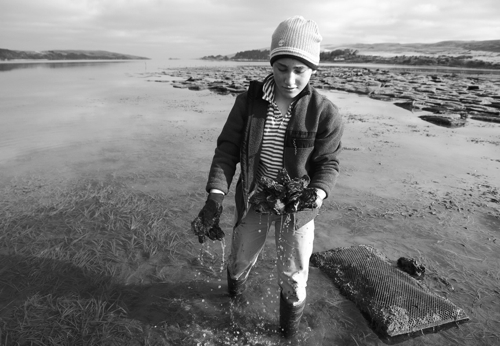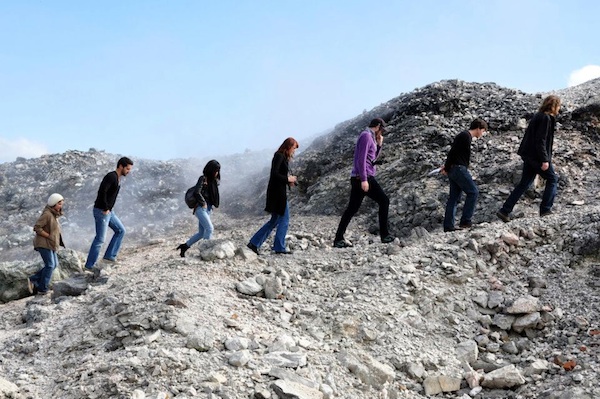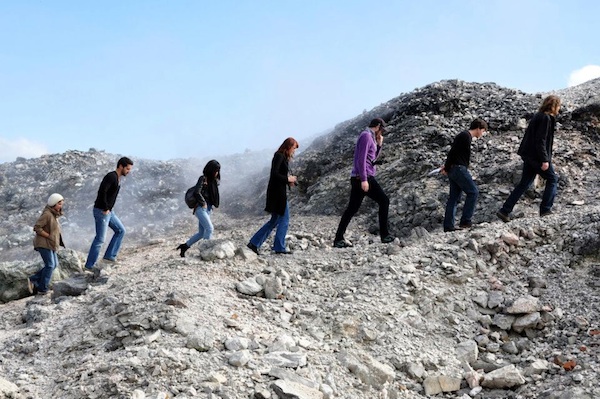 Le Biancane geothermal park.Photo: Yvone De Zeeuw Food Studies features the voices of volunteer student bloggers from a variety of different food- and agriculture-related programs at universities around the world. You can explore the full series here.
Le Biancane geothermal park.Photo: Yvone De Zeeuw Food Studies features the voices of volunteer student bloggers from a variety of different food- and agriculture-related programs at universities around the world. You can explore the full series here.
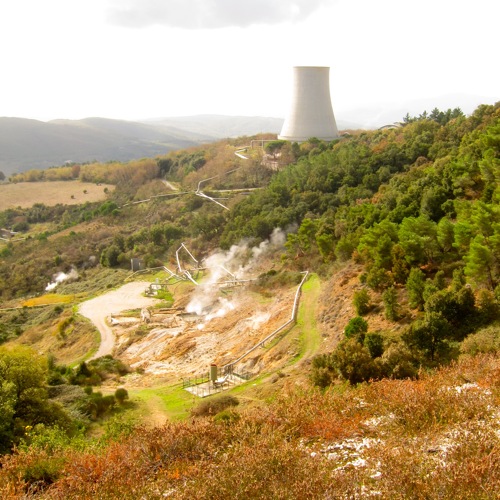 Pipelines carry steam directly to consumers from the power plant.Vapor escapes through mountains of white rocks. Steam billows out of a huge cauldron in the distance. The smell of sulfur stings my nose, and the ground i s hot to the touch. It’s easy to imagine I’m on another planet, or in some science fiction novel. But where I am is Tuscany, the Italian region famous for its beautiful landscapes and classic cuisine. And food producers here are harnessing vapor, steam, and sunlight to make the traditional products of the region. It’s not sci-fi, but it might just be the future of food.
Pipelines carry steam directly to consumers from the power plant.Vapor escapes through mountains of white rocks. Steam billows out of a huge cauldron in the distance. The smell of sulfur stings my nose, and the ground i s hot to the touch. It’s easy to imagine I’m on another planet, or in some science fiction novel. But where I am is Tuscany, the Italian region famous for its beautiful landscapes and classic cuisine. And food producers here are harnessing vapor, steam, and sunlight to make the traditional products of the region. It’s not sci-fi, but it might just be the future of food.
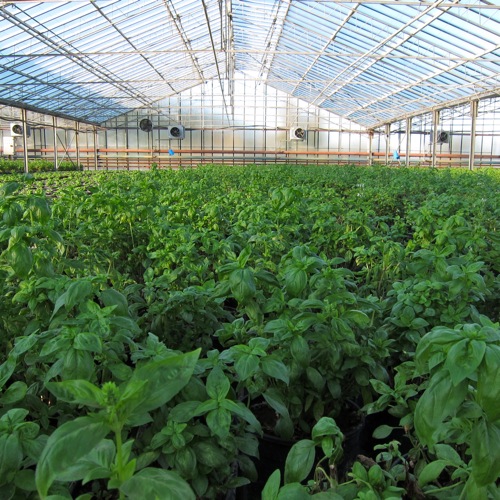 Basil greenhouse grows basil year-round with geothermal heat.Italy’s volcanic past gave Tuscany its rolling hills and fertile soil, and now it’s providing the region with a source of renewable energy. Power plants dot the landscape and steam pipelines stretch along the gentle slopes. As of 2008, approximately 13 percent of the world’s energy production came from renewable sources including hydropower, biomass, and solar. Only a sliver — 0.1 percent — was from geothermal sources. The region of Tuscany is unique in that nearly 30 percent of its energy needs are met this way. In fact, some food producers use renewable energy to run their entire operation.
Basil greenhouse grows basil year-round with geothermal heat.Italy’s volcanic past gave Tuscany its rolling hills and fertile soil, and now it’s providing the region with a source of renewable energy. Power plants dot the landscape and steam pipelines stretch along the gentle slopes. As of 2008, approximately 13 percent of the world’s energy production came from renewable sources including hydropower, biomass, and solar. Only a sliver — 0.1 percent — was from geothermal sources. The region of Tuscany is unique in that nearly 30 percent of its energy needs are met this way. In fact, some food producers use renewable energy to run their entire operation.
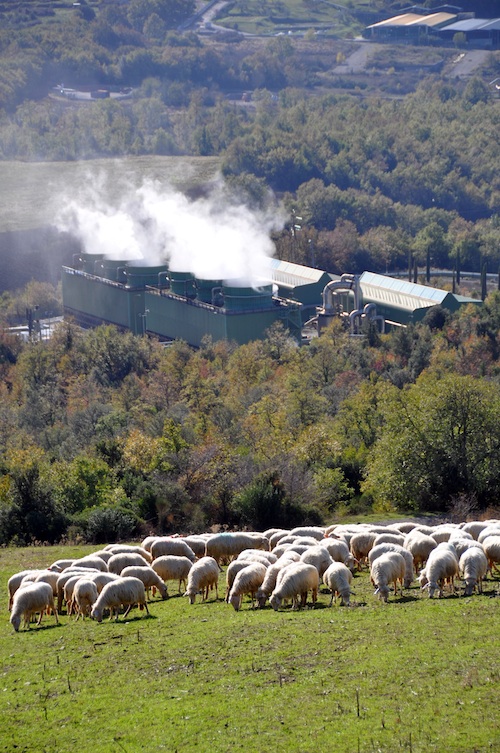 Mario Tanda’s sheep graze with a view of the geothermal plant.Take Parvus Flos; the botanical company grows basil 12 months a year in giant greenhouses covering 50 acres. It was a cold day when our group visited the farm, but inside the greenhouses it was downright balmy. Basil is a finicky plant that needs a warm environment of at least 64 degrees F. The farmers maintain a constant temperature with geothermal heat that arrives by pipeline and connects directly to the greenhouse heating system.
Mario Tanda’s sheep graze with a view of the geothermal plant.Take Parvus Flos; the botanical company grows basil 12 months a year in giant greenhouses covering 50 acres. It was a cold day when our group visited the farm, but inside the greenhouses it was downright balmy. Basil is a finicky plant that needs a warm environment of at least 64 degrees F. The farmers maintain a constant temperature with geothermal heat that arrives by pipeline and connects directly to the greenhouse heating system.
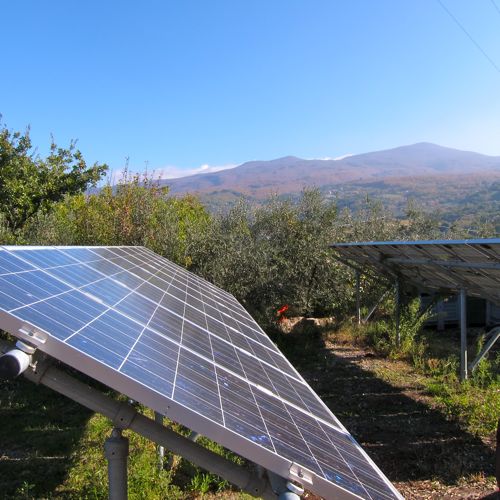 La Poderina supplies its own solar and biomass energy.Loredana Torsello is the director of the International Center for Technological Transfer for Renewable Energy Sources in Monterotondo Marittimo, Tuscany. She’s working with other associations like Slow Food Tuscany and Community Food for Renewable Energy to promote regional products grown with clean energy. Part of her job is conducting lifecycle assessments on foods grown within the scope of the project — and she’s finding huge savings. According to the studies, heating the greenhouses with fossil fuels would cost Parvus Flos around €47,500 [$63,402.99] per year; its current geothermal heating bill is one-tenth that amount.
La Poderina supplies its own solar and biomass energy.Loredana Torsello is the director of the International Center for Technological Transfer for Renewable Energy Sources in Monterotondo Marittimo, Tuscany. She’s working with other associations like Slow Food Tuscany and Community Food for Renewable Energy to promote regional products grown with clean energy. Part of her job is conducting lifecycle assessments on foods grown within the scope of the project — and she’s finding huge savings. According to the studies, heating the greenhouses with fossil fuels would cost Parvus Flos around €47,500 [$63,402.99] per year; its current geothermal heating bill is one-tenth that amount.
Mario Tanda, owner and cheese maker of Podere Paterno, produces raw milk cheeses, including the classic pecorino di Toscana, from his herd of pastured sheep. His small cheese facility is powered by electricity and steam heat, both generated from the nearby geothermal plant. Torsello’s research shows that these producers aren’t just saving money; they’re saving lots in CO2 emissions — 2,800 tons a year between the two of them, to be exact.
There are other alternative energy solutions in the region, as well.
La Poderina grows olives for oil and classic Tuscan grapes like sangiovese for wine in the town of Montegiovi. Fausto Borselli founded the all-organic farm in 1996. With help from his son Davide, solar panels were installed on the farm in 2006 as well as a biomass system to convert leftovers from the olive mill into usable energy. The farm now runs self-sufficiently, and Davide estimates they save 15 tons of CO2 emissions per year. And that’s not all. Waste water from the olive mill, which is high in antioxidants, hydrates the olive grove, and Davide is working with University of Pisa to find a use for it in cosmetics and pharmaceuticals.
Since my visit, I don’t think of Tuscany as I did before. It’s not just the home of high-quality wine, cheese, and basil — the quintessential Italian food experience, if you will. Tuscans are also using alternative energy to farm fish, cure meats, preserve fruits and vegetables, make compost, and cultivate mushrooms. And now I think the region symbolizes the possibilities of future food production.
